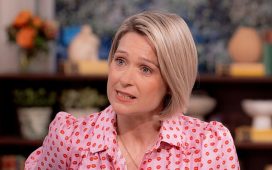There is nothing uneasy about the new head that wears “The Crown.”
In Season 3 of Netflix’s Emmy-winning chronicle of the reign of Queen Elizabeth II, Oscar winner Olivia Colman steps into Claire Foy’s kitten heels to play the British sovereign, as the series moves into the 1960s and 1970s and Elizabeth matures from a young, unsure Queen to a fortysomething jaded monarch.
The big risk pays off, as the fascinating season (streaming Nov. 17, ★★★ out of four) is as fascinating and gorgeous as the first two: enough differences to add intrigue but enough familiarity to provide a continuing narrative. Season 3 continues the sure-footed march through the major episodes in contemporary United Kingdom history.
Along with Elizabeth, the rest of the core cast also ages up with new actors, including Helena Bonham Carter, who steps into the role of Princess Margaret, Tobias Menzies, who takes on Prince Phillip, Ben Daniels as Antony Armstrong-Jones and Charles Dance, who offers a wizened performances as Lord Mountbatten. Next-generation royals Princess Anne (Erin Doherty) and Prince Charles (Josh O’Connor) are also now old enough in the series’ timeline to have stories of their own.
Cast interviews: ‘The Crown’: On set with Olivia Colman and the new cast of Netflix’s royals drama

Despite replacing its strong original cast, the new actors are so akin to their counterparts that “Crown” effortlessly transitions from the old to the new. A scene in the season premiere in which Elizabeth ponders her new portrait on British stamps to reflect her advanced age seems hardly necessary to remind the audience that she’s the same character Foy embodied.
The new season covers Britain’s rocky transition into the modern era, including Prime Minister Harold Wilson’s (Jason Watkins) tenure, the devaluation of the pound, the Aberfan disaster and the 1972 mining strike. The royal family also struggles to reckon with modernity, as Margaret and Tony’s marriage collapses, a documentary explores the Windsors’ inner workings, and Charles meets his first love, Camilla Shand (Emerald Fennell).

As in the first two seasons, the acting, costuming and production design are highlights of the series. Bonham Carter is her usually delightful, whimsical self, and Margaret seems like the role she has been waiting her whole life to play. Menzies, who carved a niche as an odious and bumbling supporting character in historical fantasy series (“The Terror,” “Game of Thrones”) is the most accomplished at embodying his predecessor in the role (Matt Smith). Although the writers’ continuing fascination with Phillip (he is the primary focus of two episodes) remains an oddity that weakens the series.
The best addition is O’Connor, who nails a carbon copy impression of the Prince of Wales’ accent and mannerisms, turning a public figure often portrayed negatively into a sympathetic (if incredibly naive) young man. The storyline of his heartbreaking romance with Camilla (which, as we know, takes decades to resolve) is a highlight of the season.

However, as good as Season 3 is, “The Crown” still faces a deep conceptual problem that’s been put into stark relief in new episodes: Elizabeth is no longer the most interesting figure in her own story. Colman is conspicuously absent through much of the season, which focuses more heavily on Phillip, Margaret and Charles, and her role in her family members’ stories is nominal at best. Despite the marquee position of Colman in the opening credits, “Crown” doesn’t feel like her show.
That’s less the fault of the actors or creator and writer Peter Morgan than of history. The simple fact is that the Queen is too good at being royal, bland, uncontroversial and dully inscrutable. Her family fills the gossip pages of British tabloids, but she stands stoically by in her charming suits and pearls clutching a handbag, and steadfastness doesn’t make for entertaining television.
Tinkering with the historical record and a bevy of seasoned British thespians can’t change this fundamental aspect of the monarch. In any other series, this would mark a natural evolution of character and story as the show ages. But this isn’t “The Windsors” or “The Crowns,” and downplaying Elizabeth in this series is jarring and distracting. It’s a shame because both Foy and Colman are so deliciously well-suited for the role. Watching Colman passively sit by as Menzies waxes poetically about the moon landing feels so wasteful of an actress at the height of her career.
Even if “The Crown” can’t pull Elizabeth back to the center of the narrative, viewers’ fascination with the royals is unlikely to ebb. The series remains fully capable of making the family a little less mysterious and a little more entertaining. And as the timeline approaches scandals and romances we know and love (Princess Diana! The Royal Wedding! Charles’ affair!), the melodrama from everyone but Elizabeth might be enough.














